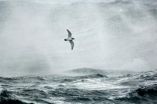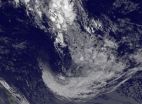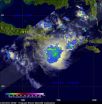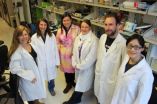(Press-News.org) EUGENE, Ore. -- (March 20, 2014) -- University of Oregon physicists using a supercomputer and mathematically rich formulas have captured fundamental insights about what happens when objects moving freely jam to a standstill.
Their approach captures jamming -- the point at which objects come together too tightly to move -- by identifying geometric signatures. The payoff, while likely far down the road, could be a roadmap to preventing overfilled conveyor belts from stopping in factories, separating oil deposits trapped in sand, or allowing for the rapid, efficient transfer of mass quantities of data packets on the Internet, say UO doctoral student Peter K. Morse and physics professor Eric I. Corwin.
Their paper "Geometric Signatures of Jamming in the Mechanical Vacuum" is online ahead of print in the journal Physical Review Letters.
"The history of the field has been looking at mechanical properties really close to the jamming transition, right where a sand pile starts to push back," said Corwin, whose research is supported by a National Science Foundation Faculty Early Career Development award. "What we're doing that is really different is we're asking what happens before the sand pile starts to push back. When it's not pushing back, you can't get any information about its mechanical properties. So, instead, we're looking at the geometry -- where particles are in relation to one another."
The problem, Corwin said, involves an ages-old question used to introduce physics in early education: Is sand a liquid, a solid or a gas? "Make a sand pile, step back and it holds its shape, so clearly it's a solid," he said. "But I can take that same sand and pour it into a bucket; it flows in and takes the shape of the container and has a level surface, so clearly sand is a liquid. Or I can put a top on the bucket and shake it around really hard, and when I do that the sand fills all of the space. Clearly sand is a gas. Except, it's none of those things.
"This has led to granular materials, or little chunks of things, being referred to as a fourth state of matter," he continued. "Is sand something else? One thing everyone agrees on -- the one feature about sand or piles of gravel or piles of glass spheres or ball bearings, that makes them really unique -- is that when spread out they can't support any load. If you keep compressing them, and they get denser and denser, you reach a density where it's like flipping a switch. All of a sudden they can support a load."
The key, the researchers said, is identifying the nearest neighbors of particles. This is done using the Voronoi construction, a method of dividing spaces into a number of regions that was devised by Georgy Feodosevich Voronoy, a Russian mathematician in the late 19th century.
"Imagine a cluster of islands in the ocean," Morse said. "If you found yourself dropped in the water you would swim to the nearest island. You could say that the island 'owns' the region of ocean closest to it and islands that 'own' adjacent patches of ocean are nearest neighbors. We use this to characterize the internal geometry of a sand pile."
To study what happens to this internal geometry as a sand pile is compressed, they entered data into the UO's new ACISS (Applied Computational Instrument for Scientific Synthesis) supercomputer, applying the Voronoi construction.
"Using these cells, called Voronoi tesslations, you can find out all you want to know about a geometric object -- its volume, surface area, number of sides -- you get it all," said Morse, who also is a fellow of the UO's GK-12 Science Outreach Program that links chemistry and physics graduate students with the state's elementary and middle schools. "All of the geometric features that we can think of so far show us that systems below jamming are very different than systems that are about to jam or that are jammed already. We end up finding that this purely geometric construct will exhibit this phase transition."
And by carrying out their computations into multidimensional spaces -- up to the eighth dimension in this project -- researchers learned that the physics of the jamming process can be simply identified by seeing what happens in the transition from 2-D to 3-D spaces. It's at that level, applying the knowledge to high-dimensional spaces, Corwin said, that application to expanding data transfer capabilities come into focus.
"The new ACISS supercomputer puts the UO at the forefront of a revolution that applies cloud computing to scientific investigation in physics, biology, chemistry, human brain science and computer science," said Kimberly Andrews Espy, vice president for research and innovation and dean of the UO Graduate School. "By incorporating the powerful ACISS computer into this project, Dr. Corwin and his team were able to examine the geometry of jamming and provide a new perspective on the process that has potential applications down the road for everything from manufacturing to computing to power production."
INFORMATION:
NSF grants DMR-1255370 and DGE-0742540 supported the research.
About the University of Oregon
The University of Oregon is among the 108 institutions chosen from 4,633 U.S. universities for top-tier designation of "Very High Research Activity" in the 2010 Carnegie Classification of Institutions of Higher Education. The UO also is one of two Pacific Northwest members of the Association of American Universities.
Sources: Eric Corwin assistant professor of physics, 541-346-4697 (lab), ecorwin@uoregon.edu; Peter Morse, doctoral student, physics, 541-346-4697, peterm@uoregon.edu
Links:
Paper: http://journals.aps.org/prl/abstract/10.1103/PhysRevLett.112.115701
Corwin faculty page: http://physics.uoregon.edu/profile/ecorwin/
GK-12 Science Outreach Program: http://materialscience.uoregon.edu/GK12/Overview.html
UO Physics Department: http://physics.uoregon.edu/
Follow UO Science on Facebook: http://www.facebook.com/UniversityOfOregonScience
UO Science on Twitter: http://twitter.com/UO_Research
More UO Science/Research News: http://uoresearch.uoregon.edu
Note: The University of Oregon is equipped with an on-campus television studio with a point-of-origin Vyvx connection, which provides broadcast-quality video to networks worldwide via fiber optic network. In addition, there is video access to satellite uplink, and audio access to an ISDN codec for broadcast-quality radio interviews.
Oregon physicists use geometry to understand 'jamming' process
New study allows scientists to visualize why free-moving objects jam when compressed
2014-03-20
ELSE PRESS RELEASES FROM THIS DATE:
Mayo Clinic researchers find genetic clue to irritable bowel syndrome
2014-03-20
ROCHESTER, Minn. — March 20, 2014 — Is irritable bowel syndrome (IBS) caused by genetics, diet, past trauma, anxiety? All are thought to play a role, but now, for the first time, researchers have reported a defined genetic defect that causes a subset of IBS. The research was published in the journal Gastroenterology.
Researchers estimate that approximately 15 to 20 percent of the Western world has IBS. It is a common disorder that affects the large intestine. Most patients with the disorder commonly experience symptoms of cramping, abdominal pain, bloating gas, diarrhea ...
Health insurance coverage increased ER use in Massachusetts
2014-03-20
WASHINGTON — The implementation of health care reform in Massachusetts – principally the expansion of health insurance coverage to nearly everyone in the state – was associated with a small but consistent increase in emergency department use, according to the findings of a study to be published online today in Annals of Emergency Medicine ("Increased Use of the Emergency Department After Health Care Reform in Massachusetts").
"This obviously has implications about what we can expect to see nationally as the roll-out of the Affordable Care Act continues," said Peter ...
Big government -- or good neighbors -- can improve people's health
2014-03-20
Lincoln, Neb., March 20, 2014 – The nation's left-leaning citizens might be pleased by the findings of a new University of Nebraska study that finds those who live in liberal states tend to be healthier.
But conservatives could also take satisfaction in the same study's conclusion that strong communities also foster better health.
"Some people might like the argument that liberal government automatically leads to healthier people, because it supports their worldview," said Mitchel Herian, a faculty fellow with the university's Public Policy Center and lead researcher ...
Plankton make scents for seabirds and a cooler planet
2014-03-20
The top predators of the Southern Ocean, far-ranging seabirds, are tied both to the health of the ocean ecosystem and to global climate regulation through a mutual relationship with phytoplankton, according to newly published work from the University of California, Davis.
When phytoplankton are eaten by grazing crustaceans called krill, they release a chemical signal that calls in krill-eating birds. At the same time, this chemical signal — dimethyl sulfide, or DMS — forms sulfur compounds in the atmosphere that promote cloud formation and help cool the planet. Seabirds ...
Wind farms can provide society a surplus of reliable clean energy, Stanford study finds
2014-03-20
The worldwide demand for solar and wind power continues to skyrocket. Since 2009, global solar photovoltaic installations have increased about 40 percent a year on average, and the installed capacity of wind turbines has doubled.
The dramatic growth of the wind and solar industries has led utilities to begin testing large-scale technologies capable of storing surplus clean electricity and delivering it on demand when sunlight and wind are in short supply.
Now a team of Stanford researchers has looked at the "energetic cost" of manufacturing batteries and other storage ...
Satellite confirms Tropical Cyclone Mike's quick disappearing act
2014-03-20
Tropical Cyclone Mike didn't even last a day in the Southern Pacific Ocean as NOAA's GOES-West satellite revealed the storm dissipating just 24 hours after it was born.
The Joint Typhoon Warning Center's second update on Tropical Cyclone Mike was its last. At 2100 UTC/5 p.m. EDT Mike was located near 24.3 south latitude and 157.9 west, about 618 nautical miles/711.1 miles/ 1,145 km southwest of Papeete, Tahiti. Maximum sustained winds were near 35 knots/40 mph/62 kph at that time.
All warnings for the Southern Cook Islands were cancelled and Mike was quickly weakening ...
Face it: Instagram pictures with faces are more popular
2014-03-20
Like them or not, there's more proof that selfies aren't going away any time soon. Georgia Institute of Technology and Yahoo Labs researchers looked at 1.1 million photos on Instagram and found that pictures with human faces are 38 percent more likely to receive likes than photos with no faces. They're also 32 percent more likely to attract comments. The study is one of the first to examine how photos with faces drive engagement on large-scale, image-sharing communities.
The researchers also found that the number of faces in the photo, their age or gender didn't make ...
NASA sees ex-Tropical Cyclone Gillian's remnants persist
2014-03-20
NASA's TRMM satellite continues to follow the remnants of former Tropical Cyclone Gillian as it moved from the Southern Pacific Ocean into the Southern Indian Ocean where it appears to be re-organizing.
The persistent remnants of tropical cyclone Gillian have moved westward over 2,700 km/1,674 miles since forming in the Gulf of Carpentaria on March 8, 2014.
Gillian's coherent remnants were located just to the southeast of the Indonesian island of Java when the Tropical Rainfall Measuring Mission or TRMM satellite flew overhead on March 20, 2014 at 0415 UTC/12:15 a.m. ...
Interpreting neuroimages: The technology and its limits
2014-03-20
Neuroimages play a growing role in biomedical research, medicine, and courtrooms, as well as in shaping our understanding of what it means to be human. But how helpful are they at answering complex questions such as: What is depression? Is a defendant lying? Do we have free will?
These are among the topics explored in Interpreting Neuroimages: An Introduction to the Technology and Its Limits, a special report of the Hastings Center Report. It is edited by Josephine Johnston, a research scholar and director of research, and Erik Parens, a senior research scholar, and ...
Proteins that control energy use necessary to form stem cells
2014-03-20
Proteins that regulate energy metabolism are essential for stem cell formation, University of Washington researchers find.
Two proteins that control how cells metabolize glucose play a key role in the formation of human stem cells, UW researchers report.
The findings advance scientists' understanding of stem cell development but also suggest that the proteins, which also play a role in the process that transforms normal cells into cancer stem cells, might also be targets for new cancer therapies, the researchers write.
The findings appear online in the journal Cell ...
LAST 30 PRESS RELEASES:
Modulating key interaction prevents virus from entering cells
Project explores barriers to NHS career progression facing international medical graduates
Jeonbuk National University researchers explore the impact of different seasonings on the flavor perception of Doenjang soup
Two Keck Medicine of USC Hospitals named Leapfrog Top Teaching Hospitals
World-first discovery uncovers how glioblastoma tumours dodge chemotherapy, potentially opening the door to new treatments
A fatal mix-up: How certain gut bacteria drive multiple sclerosis
New AI tool identifies not just genetic mutations, but the diseases they may cause
Deep-learning model predicts how fruit flies form, cell by cell
Combination pills for high blood pressure may simplify treatment, improve long-term health
Immune system keeps mucosal fungi in check
Neurons within the brain use simple rules to localize genetic messages
Electrodes created using light
Second-hand gift-giving is a well-deliberated decision
How human interaction drove evolution to make bears less aggressive
National Poll: Few parents offer teens guidance on healthy eating during holiday season
Cannabis derivatives could provide new ovarian cancer treatments
Raising strong yeast as a petroleum substitute
Clues to the origin of hot Jupiters hidden in their orbits
Canada’s reduced pledge to Global Fund will impact domestic health
1 in 4 children with major traumatic injuries not cared for in pediatric trauma centres
Duke and Duke-NUS’ joint cross-population research to uncover "East-West" differences in disease and care
Scientists to ‘spy’ on cancer- immune cell interactions using quantum technology breakthrough
Tech savvy users have most digital concerns
Making lighter work of calculating fluid and heat flow
Normalizing blood sugar can halve heart attack risk
Lowering blood sugar cuts heart attack risk in people with prediabetes
Study links genetic variants to risk of blinding eye disease in premature infants
Non-opioid ‘pain sponge’ therapy halts cartilage degeneration and relieves chronic pain
AI can pick up cultural values by mimicking how kids learn
China’s ecological redlines offer fast track to 30 x 30 global conservation goal
[Press-News.org] Oregon physicists use geometry to understand 'jamming' processNew study allows scientists to visualize why free-moving objects jam when compressed






